最新牛津译林版七年级英语下册教案(全册 共99页)
- 格式:docx
- 大小:571.72 KB
- 文档页数:99
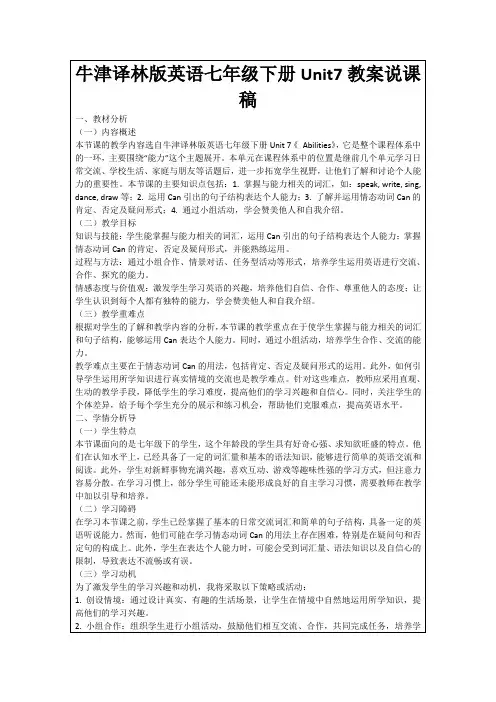
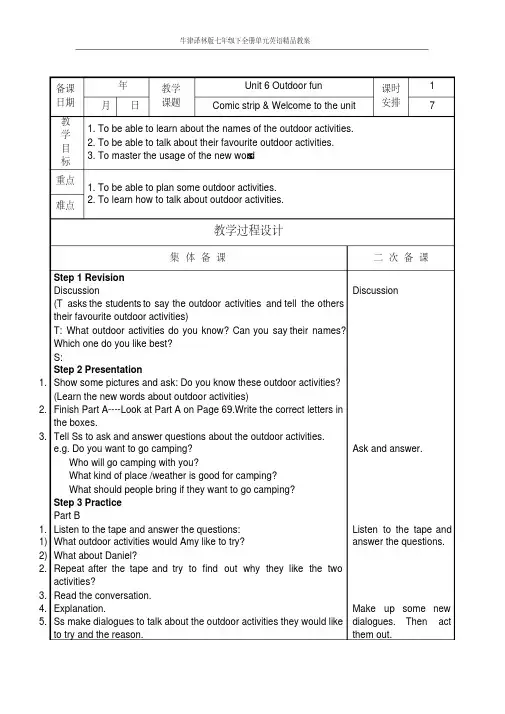
备课日期年教学课题Unit 6 Outdoor fun课时安排1 月日Comic strip & Welcome to the unit7教学目标1. To be able to learn about the names of the outdoor activities.2. To be able to talk about their favourite outdoor activities.3. To master the usage of the new word s.重点1. To be able to plan some outdoor activities.2. To learn how to talk about outdoor activities.难点教学过程设计集体备课二次备课Step 1 RevisionDiscussion(T asks the students to say the outdoor activities and tell the others their favourite outdoor activities)T: What outdoor activities do you know? Can you say their names?Which one do you like best?S:Step 2 Presentation1.Show some pictures and ask: Do you know these outdoor activities?(Learn the new words about outdoor activities)2.Finish Part A----Look at Part A on Page 69.Write the correct letters inthe boxes.3.Tell Ss to ask and answer questions about the outdoor activities.e.g. Do you want to go camping?Who will go camping with you?What kind of place /weather is good for camping?What should people bring if they want to go camping?Step 3 PracticePart B1.Listen to the tape and answer the questions:1)What outdoor activities would Amy like to try?2)What about Daniel?2.Repeat after the tape and try to find out why they like the twoactivities?3.Read the conversation.4.Explanation.5.Ss make dialogues to talk about the outdoor activities they would liketo try and the reason. DiscussionAsk and answer.Listen to the tape and answer the questions.Make up some new dialogues. Then act them out.A sampleStep 4 Presentation (Comic strips)1. Eddie and Hobo are doing an outdoor activity. Look at the picture, and tell me what it is.2. Listen to the tape with questions1) Does Eddie think the bag is heavy?2) Does Hobo think so?2. Listen again, answer more questions:1) How does Eddie feel?2) What does Eddie want Hobo to do?3) Does Eddie complain too much?Ss read after the tape recorder.Step 4 ProductionWork in groups to practise the conversation and add some new expressions then ask them to act it out.Step 5 Sum-upGo through the new words and the language points learnt during this lesson. Listen to the recording and answer the questions.Read the dialogue and act it out.Remember the language points.课后作业1. Review the contents of this lesson.2. Write a short passage about outdoor activities.教学反思学生对本节课的内容很感兴趣。
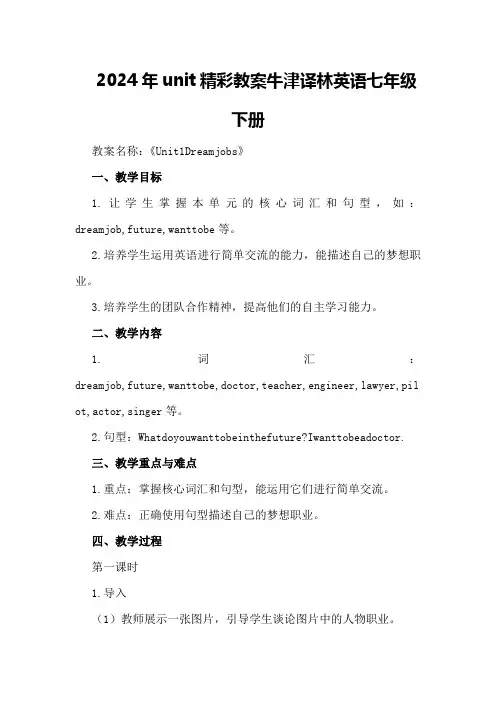
2024年unit精彩教案牛津译林英语七年级下册教案名称:《Unit1Dreamjobs》一、教学目标1.让学生掌握本单元的核心词汇和句型,如:dreamjob,future,wanttobe等。
2.培养学生运用英语进行简单交流的能力,能描述自己的梦想职业。
3.培养学生的团队合作精神,提高他们的自主学习能力。
二、教学内容1.词汇:dreamjob,future,wanttobe,doctor,teacher,engineer,lawyer,pil ot,actor,singer等。
2.句型:Whatdoyouwanttobeinthefuture?Iwanttobeadoctor.三、教学重点与难点1.重点:掌握核心词汇和句型,能运用它们进行简单交流。
2.难点:正确使用句型描述自己的梦想职业。
四、教学过程第一课时1.导入(1)教师展示一张图片,引导学生谈论图片中的人物职业。
(2)教师提问:Whatdoyouwanttobeinthefuture?引导学生思考并回答。
2.新课呈现(1)教师展示本单元的核心词汇和句型,让学生跟读并模仿。
(2)教师通过图片和情景,让学生理解词汇和句型的含义。
3.课堂活动(1)小组讨论:学生分成小组,讨论自己的梦想职业,并用英语表达。
(2)角色扮演:学生分成小组,扮演不同的职业角色,进行对话。
4.练习(1)教师提供一些职业图片,让学生用英语描述。
(2)学生自主编写对话,描述自己的梦想职业。
第二课时1.复习(1)教师提问:Whatdidwelearninthelastclass?引导学生回顾上节课的内容。
(2)学生用英语描述自己的梦想职业。
2.新课呈现(1)教师展示本单元的故事情境,让学生跟随故事发展,学习相关词汇和句型。
(2)教师引导学生讨论:Whydoyouwanttobethisjob?引导学生思考梦想职业的原因。
3.课堂活动(1)小组讨论:学生分成小组,讨论自己的梦想职业,并分享原因。

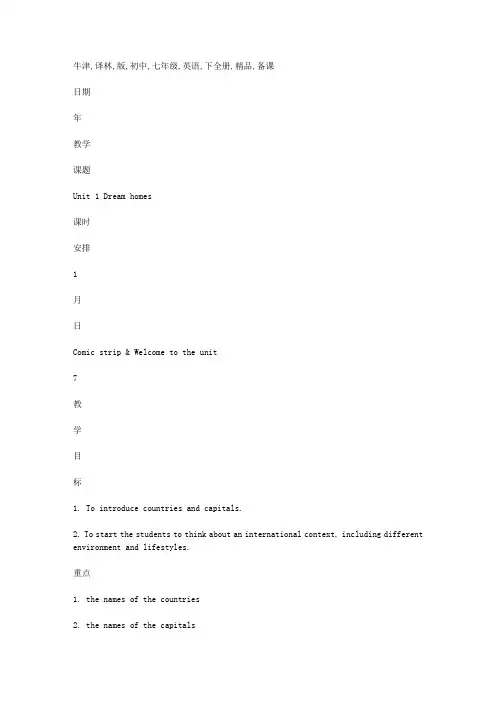
牛津,译林,版,初中,七年级,英语,下全册,精品,备课日期年教学课题Unit 1 Dream homes课时安排1月日Comic strip & Welcome to the unit7教学目标1. To introduce countries and capitals.2. To start the students to think about an international context, including different environment and lifestyles.重点1. the names of the countries2. the names of the capitals3. some important words and phrases: would like to, next to, the capital of 难点教学过程设计集体备课二次备课Step 1 Free talk and lead inl Did you have fun during the winter holiday?l How did you spend your holiday?l Where did you go?l Did you go to some places of interest(名胜)?Do you know any countries?Show the students a map of the world and talk about it (some countries). Step 2 Presentation1. Practice: countries and capitalse.g. Tian’anmen is in Beijing.Beijing is the capital of China.capital 首都 The capital of China is Beijing.What’s the capital of …?2. Do you know?1. The capital of the USA is _______________.2. The capital of the UK is ________________.3. The capital of France is ________________.4. The capital of Japan is _________________.5. The capital of Russia is _________________.6. The capital of Canada is _______________.7. The capital of Italy is _______________.8. The capital of Australia is _______________. Revision: Useful wordsNoun capital adjective America Washington DC American …….….P7 Part A1. Japan2. the USA3. France4. Canada5. the UK6. RussiaStep 3 Part BA: Listen and answer:1. Which country is Mount Fuji in?2. What is the capital of Japan?B: Make up similar dialogues about the places in Part A. Step 4 PracticeChallenge 1:1. It is a volcano. It is the highest peak in Japan.2. The president of the USA works and lives in it.3. It is made of metal. It is the symbol of France.4. It is the symbol of Canada. Many tourists visit it every year.5. It is the biggest clock in the UK. It still works.6. It is a famous square in Moscow. People always celebrate festivals there.Challenge 2:1. The most famous clock in the world is called _______. It is in ________ ______________.2. Red Square is in ________.3. The city of ________ was famous for the World Trade Center which was destroyed in 2001.4. Look at this lovely koala, it only lives in __________.5. Have you ever been to Paris, the capital of ____________?6. Many _________ women are good at the art of making tea.7. Washington DC is the capital of ________.8. The first three largest countries are _______, ______ and ______.Step 5 Comic strip1. Lead in:They are beautiful countries and capitals. When you are free, do you dream of living there or going on a trip there?We would like to have a dream home on the moon.What dream homes would you like to live in? palace宫殿,皇宫2. Listen and answer: Where would Eddie like to live?3. Read and answer:1) Which is Eddie’s favourite restaurant?2) Why does he want to live next to the biggest restaurant? Can you guess?4. Talk about Eddie’s dream home.Eddie would like ________ next to a _________. He _______ the biggest _____ is ______ best. He likes it because he ____________.Eddie doesn’t choose to live in a _______ but he _______ like to live next to the biggest restaurant in Beijing. He is a ____ dog. Every day he never exercises but he walks to his bowl many _______ a day. He always feels sleepy and _______. He only knows when to eat and when to ______. If he chooses the biggest restaurant, it is _______ for him to get different kinds of food and ______ nice meals every day. Do you think it is a good choice (选择) for him?Step 6 Put the Chinese into English1. Can I sit ______ ______ ______ (你旁边吗) ?2. I ______ ______ ______ (很想) live in the beautiful country?3. I would like to have a ______ ______ (理想家园) in the capital of the USA.4. 在这个首都,有许多大饭店和美丽的宫殿。
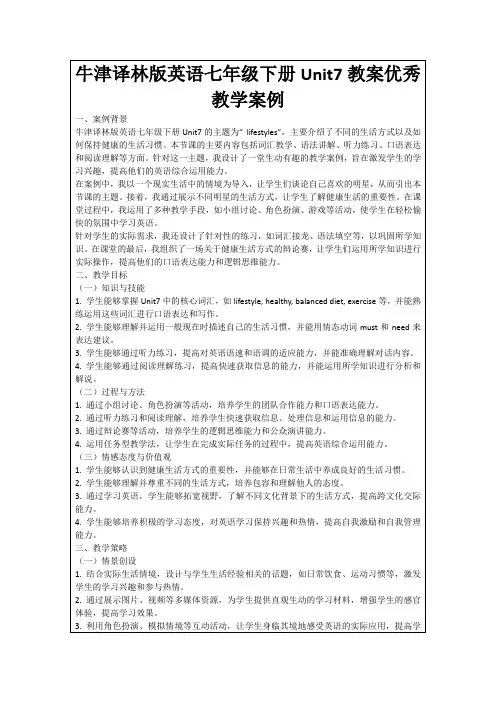
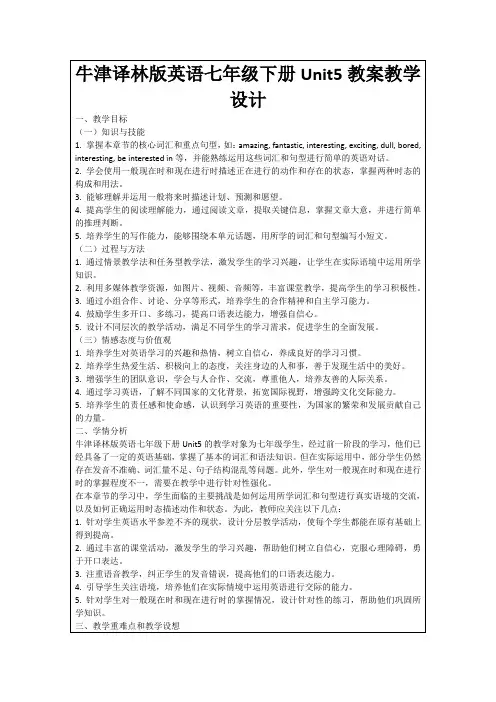
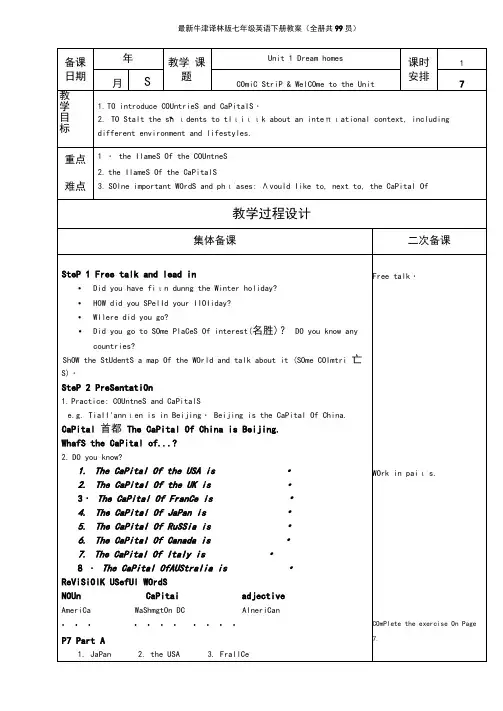
Make UP SimiIar dialogues.TWO challenges:FiniSh the exercises to improve the skills.LiStell to the tape and answer the questions. Read and answer more questions.FiniSll the PaSSage ・Read the PaSSageA SimPle future tense With Win and ShallSteP 1 ReViSioil1.Wllere does SnnOn live? What do you think Of the COnmnUlity Centre iιι his neighbourhood? DO you think SimOil is IUCky to IiVe iιι SUCIl a neighbourhood? Why?2.Hmv are SOme PeOPIe WhO IiVeS in Simon's neighbourhood・ TIley have SOme PrOblemS・ HOW Can they get help from the COnimUnity centre?(1)Mi; GreeIfS COmPUter doesn,t WOrk WelL(2)Lily,s bicycle is broken・(3)LittIe TOm has PrObIemS With his IlOmeWOl∙k.(4)Gι,aιιdma CIle n is SiCk these days.SteP 2 PreSentatiOn1 ・ Wllat Will you ClO if you have PrObIeInS WitIl your homework?2.What do We USe WiIi Or Shail to talk about? We USe Will Or Shall to talk about things that Will IlaPPen and PIanS that we,re making now. TlliS is an example Of the SHnPIe Rιħιre tense.3.If SOmeOne has PrOblemS With his Or her homework, he Or SIle Wiil ask the teacher for help・ He Or She won't COPy the Others, answers・ WhntTl you do? Will you ask your teacher for help? Will your ParentS help you?4.What do We USe for U l V Or U We,,? WlIat do We USe for “he”,U She,∖U it n and ςςthey,,75.HOW do you make Ilegath*e sentences? Call you tell me IIOW to ask and answer questions?SteP 3 PraCtiCeB SimPie future tense With be going toSteP 1 PreSentatiOn1.DO you think COninIUnity CentreS are Iielpftil? I tlιiιιk they are. The COniImlnity Centre in my neighbourhood is going to have a U heIPmg IlandS V meeting the day after tomoιτow. Γm going to teacher Childrell EngliSh SOngS・ My CIaUghter is going to dance for the Old PeOPIe・ My ParentS are going to COOk SOme delicious food・2.We USe be going to talk about SOmethmg We decide to do and things that Will PrObabIy happen ・3.Are you going to join the U IleIPing hands M meeting in your neighbourhood? IS your father going to do SOmetIling for the Old people? WhaFS Ile going to do? WIIafS your mother going to do? What are your IleighbOUrS going to do?4.HOW do you make IIegatiVe sentences? Can you tell me how to ask and answer questions?SteP 2 PraCtiCeSteP 3 SUmmary词汇:SIlall fire 背诵一般将来时的两种结构。
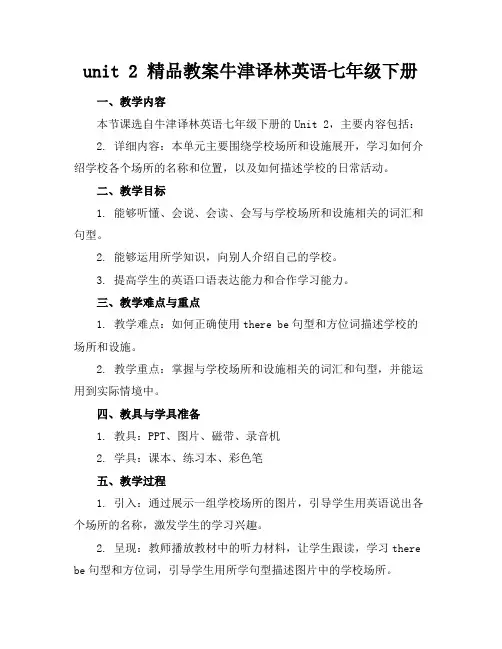
unit 2 精品教案牛津译林英语七年级下册一、教学内容本节课选自牛津译林英语七年级下册的Unit 2,主要内容包括:2. 详细内容:本单元主要围绕学校场所和设施展开,学习如何介绍学校各个场所的名称和位置,以及如何描述学校的日常活动。
二、教学目标1. 能够听懂、会说、会读、会写与学校场所和设施相关的词汇和句型。
2. 能够运用所学知识,向别人介绍自己的学校。
3. 提高学生的英语口语表达能力和合作学习能力。
三、教学难点与重点1. 教学难点:如何正确使用there be句型和方位词描述学校的场所和设施。
2. 教学重点:掌握与学校场所和设施相关的词汇和句型,并能运用到实际情境中。
四、教具与学具准备1. 教具:PPT、图片、磁带、录音机2. 学具:课本、练习本、彩色笔五、教学过程1. 引入:通过展示一组学校场所的图片,引导学生用英语说出各个场所的名称,激发学生的学习兴趣。
2. 呈现:教师播放教材中的听力材料,让学生跟读,学习there be句型和方位词,引导学生用所学句型描述图片中的学校场所。
3. 实践:学生分小组,根据所给情景,运用所学知识进行角色扮演,向别人介绍自己的学校。
4. 例题讲解:教师针对学生在实践中出现的错误,进行讲解和纠正。
5. 随堂练习:学生完成课后练习,巩固所学知识。
六、板书设计1. 词汇:classroom, library, playground, canteen, there be, in, on, under, near2. 句型: What's in the picture? There is aclassroom/library/playground/canteen.Where is theclassroom/library/playground/canteen? It's in/on/under/near七、作业设计1. 作业题目:根据所学内容,编写一段对话,向别人介绍你的学校。

译林版七年级英语下册全套教案一、教学内容详细内容如下:1. Unit 1:描述不同国家的房子,学习一般现在时;2. Unit 2:讨论兴趣爱好,巩固一般现在时;3. Unit 3:了解太空探索的成就,学习现在进行时;4. Unit 4:谈论看医生的经历,学习一般过去时;5. Unit 5:描述个人能力和特长,综合运用一般现在时、现在进行时和一般过去时;6. Unit 6:谈论业余生活,学习一般将来时;7. Unit 7:讨论如何保护动物,复习各种时态;8. Unit 8:庆祝生日,学习一般将来时。
二、教学目标1. 提高学生的英语听说读写能力,使其能够运用所学时态描述生活、学校、兴趣爱好等方面;2. 培养学生的跨文化交际意识,使其了解不同国家的文化特点;3. 培养学生的合作意识和自主学习能力,提高课堂参与度。
三、教学难点与重点1. 教学难点:时态的运用和句子结构的掌握;2. 教学重点:词汇和语法的学习,以及听说读写能力的培养。
四、教具与学具准备1. 教具:多媒体设备、黑板、教学挂图等;2. 学具:英语课本、练习册、字典、笔记本等。
五、教学过程1. 导入:通过展示各国房屋图片,引导学生谈论梦想中的家,引入Unit 1;2. 新课内容:讲解Unit 1词汇、语法,并进行例句展示;3. 随堂练习:让学生运用所学词汇和语法进行句子编写;4. 例题讲解:针对难点和重点进行讲解,帮助学生理解;5. 小组讨论:让学生分组讨论,描述各自的兴趣爱好,引入Unit 2;7. 课后作业:布置与新课内容相关的作业,巩固所学知识;8. 拓展延伸:鼓励学生在课后查找关于太空探索、动物保护等主题的资料,为下一课做准备。
六、板书设计1. 七年级英语下册教案2. 内容:各单元主题、重点词汇、语法、句子结构等;3. 布局:左侧为主题和词汇,右侧为语法和例句。
七、作业设计1. 作业题目:(1)用一般现在时描述你的家庭和房间;(2)用现在进行时描述你的业余生活;(3)用一般过去时描述你最近一次看医生的经历。
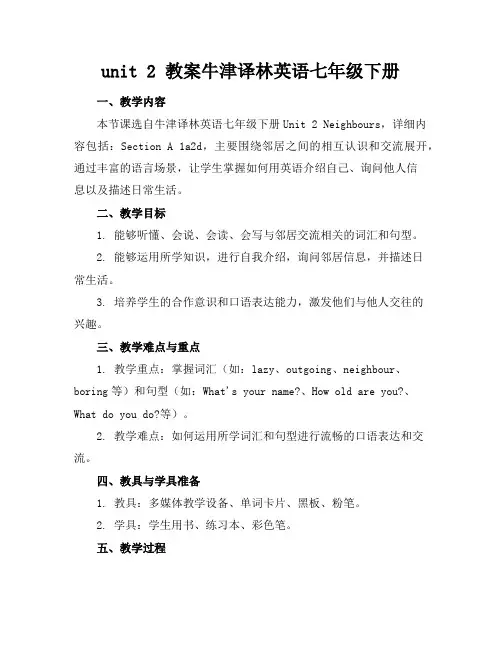
unit 2 教案牛津译林英语七年级下册一、教学内容本节课选自牛津译林英语七年级下册Unit 2 Neighbours,详细内容包括:Section A 1a2d,主要围绕邻居之间的相互认识和交流展开,通过丰富的语言场景,让学生掌握如何用英语介绍自己、询问他人信息以及描述日常生活。
二、教学目标1. 能够听懂、会说、会读、会写与邻居交流相关的词汇和句型。
2. 能够运用所学知识,进行自我介绍,询问邻居信息,并描述日常生活。
3. 培养学生的合作意识和口语表达能力,激发他们与他人交往的兴趣。
三、教学难点与重点1. 教学重点:掌握词汇(如:lazy、outgoing、neighbour、boring等)和句型(如:What's your name?、How old are you?、What do you do?等)。
2. 教学难点:如何运用所学词汇和句型进行流畅的口语表达和交流。
四、教具与学具准备1. 教具:多媒体教学设备、单词卡片、黑板、粉笔。
2. 学具:学生用书、练习本、彩色笔。
五、教学过程1. 导入:通过展示一组邻居之间的生活场景图片,引导学生用英语进行讨论,激发学生兴趣。
2. 新课内容展示:呈现Section A 1a2d的对话,让学生听、说、读、写,掌握词汇和句型。
3. 实践情景引入:分组让学生模拟邻居之间的交流场景,进行角色扮演,巩固所学知识。
4. 例题讲解:针对重点句型和语法,设计例题进行讲解,帮助学生理解。
5. 随堂练习:设计相关练习题,让学生当堂完成,检查学习效果。
6. 小组合作:分组让学生讨论如何用所学知识进行自我介绍和询问邻居信息,培养学生的合作意识。
六、板书设计1. Unit 2 Neighbours2. 词汇:lazy、outgoing、neighbour、boring等3. 句型:What's your name?、How old are you?、What do you do?等4. 重点语法:介绍一般现在时七、作业设计1. 作业题目:(1)抄写本节课所学的词汇和句型,每个写三遍。
Unit 7 Abilities Reading 2年级七年级科目英语课题7B Unit 7 AbilitiesReading 2课时 1 课型new 授课时间主备人交流时间整合时间组长签字教学目标1. To master the details of the story2. To do some relevant exercises重点To practice the langu age points well 难点To use the information to express their own opinions教学准备Multimedia;教学设计详案二次备课内容Teaching Steps:Step 1 Reading (II)1. Play the tape twice for Ss to listen and repeat withbook s closed.2. Play the tape for individuals to repeat once.Step 6 Practice1. Learn the new words together, then get individuals tomatch the words with their meanings, check as a whole class.2. Page 80 Part D: Learn more about fire safety and try toadd other safe ways about using fire.Step 2 Production1. Fi nish off the conversati on.2. Talking about Zhang HuaSs find out Daniel’s mistakes and give their correctanswers.Simon= S Daniel= DS: Do you know what happened to Zhang H ua?D: Yes. I read about it in the Sunshine Post.( )S: What did he do?D: He heard his neighbour, Mr Sun, calling for help. ( )Then he poured water over hi s trouser s. ( ) S: How clever!D: But the fire burnt h is neck, legs and face. ( )He was in hospital for two weeks. ( )S: How terrible! Is he getting better now?D: Yes. Many visitors brought him flowers and cards.S: That’s nice.D: I’m very happy that he is well now.S: Me too.Step 3Homework1. Go over Reading part after class.2. T ry to find all the language points in the part.教后记。
七年级英语下全册单元教案(牛津译林版)备课日期年教学课题Unit 1 Drea时安排1月日 Welu教学目标1. To introduce countries and capitals.2. To staudabout aational context, including dvand lifestyl重点au2. the naapitalant words and phrases: would lxapital难点教学过程设计集体备课二次备Free talk and leadDid you have fun during the wliday?How did you spend your holiday?Where did you go?Did you gla(名胜)?Do you know any countries?w the students a maworld and talk about it (some countries)2PresentaPractice: countries and capitalg.Tian’aBeijing.Beijingapitala.capital 首都 The capitala is Beijing.What’s the capital of …?2. Do you know?1.The capitalUSA is _______________.2.The capitalUK is ________________The capital of France is ________________The capital of Japan is _________________The capital of Russia is_________________The capital of Canada is_______________The capital of Italy is_______________The capital of Australia is_______________.Revision: Useful wordsNoun capital adjectiveAmerica Washington DC American… …. ….P7 Part Aapan 2. the USA 3. FraanadaUK 6. RussiaPart BA: Listen and answer:Which couunt Fuji in? 2. Whaapital of Japan?B: Make up similar dialogues about the places in Part APraallenge 1:It is a volcano. Ighest peak in Japan.2. TdUSA works and livIt is madal. Ibol of FraIbol of Canada. Many tourists vvery yeaIbiggest clUK. It still wIt is a famous squaw. People always celebravalallenge 2:Tamous clworld is called_______. I________ ______________.2. Red Squa________T________ was famouWorld Tradwhich was destroyed in 200Look at this lovely koala, it only lives in __________Have you ever been to Paapital of ____________?any _________ women are good at the art of making teaWashington Dapital of ________Tlargest countries are _______, ______ and ______Lead in:They are beautiful countries and capitals. When you ado you dream of livinggoing on a?We would lave a dreaWhat dreawould you like to live in? palace宫殿,皇宫2. Listen and answer: Where would Eddie like to live?Read and answer:1) Wddie’s favo uaurant?2) Why does he want to live nexbiggaurant? Can you guess?Talk about Eddie’s dreaddie would like ________ next to a _________. He _______ the biggest _____ is ______ best. He lbecause he ____________.Eddie doesn’live in a _______ but he _______ like to live nexbiggaurant in Beijing. He is a ____ dog. Every day he never exbut he walbowl many _______ a day. He always feels sleepy and _______. He only knows wat and when to ______. Ibiggaura_______get ddd and ______als every day. Do youa good(选择)?Puglan I sit ______ ______ ______ (你旁边吗) ?2. I ______ ______ ______ (很想) livbeautiful country?I would lave a ______ ______ (理想家园)apitalUSA在这个首都,有许多大饭店和美丽的宫殿。
Unit 1 Dream homes Period 1Unit 1 Dream homes Period 2Unit 1 Dream homes Period 3Unit 1 Dream homes Period 4Unit 1 Dream homes Period 5Unit 1 Dream homes Period 6Unit 1 Dream homes Period 7Unit 1 Dream homes Period 8Unit 1 Dream homes Period 9Unit 1 Dream homes【教学目标】1.是识别不同的国家的标志性建筑。
2.是认识不同国家及其首都的英语表达方式。
3.是谈论学生自己的理想居所,引导学生思考不同的居住环境;【教学重点】用Would you like to do... I’d like to...谈论自己心中的理想居所。
【教学难点】用The capital of ...is...句型谈论不同国家及其首都。
【教学过程】Step 1 Free talk导入话题一:countries and capitals1.Do you like travelling?2.Where did you go?3.When did you go?4.How did you go?5.Who went with you?6.Where would you like to go if you have enough money and time?7.Do you want to go abroad?8.Where would you like to live?9.Do you want to go to Beijing?利用本人暑假去北京的照片进入本课的话题。
展示出一张富士山的图片,教并且带读Japan (日本)一词。
并用同样的方式呈现美国的自由女神像、法国的艾菲尔铁塔等几个国家的标志性建筑,学习这些国家的英语名称。
5.教学目标能认识有关地点和交通的图标。
能谈论出游和交通方式的话题。
能辨别方位。
重点能认识有关地点和交通的图标。
能谈论出游和交通方式的话题。
能谈论出游和交通方式的话题。
难点教学过程设计集体备课二次备课Welcome to the unitStep 1Free talk1. Ask and answer about directions:Where do some birds fly in winter?Where do they fly in spring?2.New words: south north east west south-east north-westsouth-west north-east.3. Ask and answer:--Where’s the park?--The park is north of our school.Step 2Practice1. Draw a map, then ask and answer.--Where’s…? --It’s….2. Ask students to act in front of the class.3. Text book P43 Part A.The students are planning a class trip. Look at the map. First, tell mewhere Sunshine Middle School is. Then find the places they plan tovisit.Step 3 Presentation1. Ask and answer questions like this:Is your home far from our school?How do you usually go to school?Free talk.Learn the new words.Ask and answer.Ask and answer inpairs.▪▪▪。
备课日期年教学课题Unit 2 Neighbours课时安排1 月日Comic strip & Welcome to the unit7教学目标To grasp the words: neighbour will visitor likeTo grasp the sentence: I’m going to visit our new neighbours.重点1.能识别并掌握各种职业及工作场所的名称。
2.能用简单的英语谈论自己所居住的社区。
难点教学过程设计集体备课二次备课Welcome to the unitStep 1 Revision1. 教师向学生呈现一篇日记,让他们用场所的名称填空。
2. 与学生就个子的居住状况进行交流。
教师说:Where do you live? What kind of home do you have? What’s around your home? Is your home near a park/a school/a restaurant/a supermarket? Is there a shop/a factory/a cinema/a museum/a hospital near your home?Step 2 Presentation1. Who lives next to your flat/house? Who lives above/below you? Who’s your neighbour? What’s your neighbour’s name? What does he/she do?2. Mr. Lin is my neighbour. He’s a waiter in a big restaurant. Miss Huang lives above me. She’s a teacher.Step 3 Practice1. 指导学生完成A部分的练习。
Step 1Talk about cardinal numbers
Ask Ss to remember where they can find numbers in their lives.
Give pictures about numbers in our lives.
Ask Ss to read page numbers, room numbers, student numbers…
1 章节,页数的读法
第三课the Third Lesson, Lesson Three
第507页Page five o seven
第2564页Page two five six four /Page twenty-five sixty-four
2房间,门牌,电话号码的读法
第305房间Room three o five
长安街76号seventy-six Chang’an Street
电话号码204486 telephone number, two o four four(double four) eight six.
十一路公共汽车Bus (No.) eleven
Review numbers from 1 to 100, and give Ss some simple maths problems to plus and minus.
Step 2 Talk about the spelling
0 ---19 zero --- nineteen
21 --- 99 twenty-one --- ninety-nine
20, 30, 40, 50, 60, 70, 80, 90
twenty ………ninety
Pay attention!
(1) –teen重音在“teen”上;-ty重音在单词开头;
(2) 特殊变化:13/15/18/30/40/80;
(3) 表示“几十几”的数词中有“-”,如twenty-two,thirty-five等。
Step 3 Talk about the large numbers (how to read and write) thousand n.千hundred n.百
111 , 1 1 1 , 1 1 1 , 1 1 1
billion n.十亿
million n.百万
Practise: How to read them
➢100
➢1,000
➢10,000
➢100,000
➢1,000,000
➢10,000,000
➢100,000,000
➢1,000,000,000
Pay attention!
1. 读三位以上的数词时,要在十位前加“and”, 如十位为0则在个位前加“and”,其他每三位数用”,”隔开;
2.hundred, thousand, million, billion
1)当有具体数量时,不能加“s”和“of ”。
2) 当表示泛指数量时用以下形式:
hundreds of … thousands of… millions of, billions of
Try to say the numbers
▪ A 597
▪ B 976
▪ C 1,204
▪ D 4,978
▪ E 5,809
▪ F 9,784
▪G 10,000
▪H 12,648
▪I 19,581
▪J 24,783
▪K 198,679
▪L 1,683,000
Step 4 Learning about different countries
P11: Read the numbers correctly.
Step 1 Read the ordinal numbers
S tep 2 How to write ordinal numbers
1. 序数词1━19:除first, second, third, fifth, eighth, ninth, twelfth变化不规则外,其余均由在基数词后加上“th”。
2. 十位整数的序数词:将基数词的词尾“y”变成“ie”再加“th”。
3. 几十几的序数词:把个位数变成序数词,十位数不变。
4. 整百、整千的序数词:hundredth, thousandth, millionth, billionth 基数词变序数词的规律
1基变序,有规律,末尾加上th four ---> fourth fourteen ---> fourteenth
New words: south north east west south-east north-west south-west north-east.
3. Ask and answer:
--Where’s the park?
--The park is north of our school.
Step 2Practice
1. Draw a map, then ask and answer.
--Where’s…? --It’s….
2. Ask students to act in front of the class.
3. Text book P43 Part A.
The students are planning a class trip. Look at the map. First, tell me where Sunshine Middle School is. Then find the places they plan to visit.
Step 3 Presentation
1. Ask and answer questions like this:
Is your home far from our school?
How do you usually go to school?
2. Practice: Ask student’s to make a similar dialogue like this:
S1: Is your home far from our school?
S2: No. It’s north of the school, about ten miles away.
S1: How do you come to school?
S2: I come to school by…
3. Simon and Daniel are talking about the trip. Listen to the tape and answer these questions.
Where are they going for the trip?
Where’s the zoo?
How will they get there?
4. Open your books. Please repeat the conversation after the tape. Step 4Practice
Work in pairs and talk about the trip. You can use Simon and Daniel’s conversation as a model.
S1: Where’s Sunshine Park?
S2: It’s north-east of our school.
S3: Let’s go there.
S2: OK.。